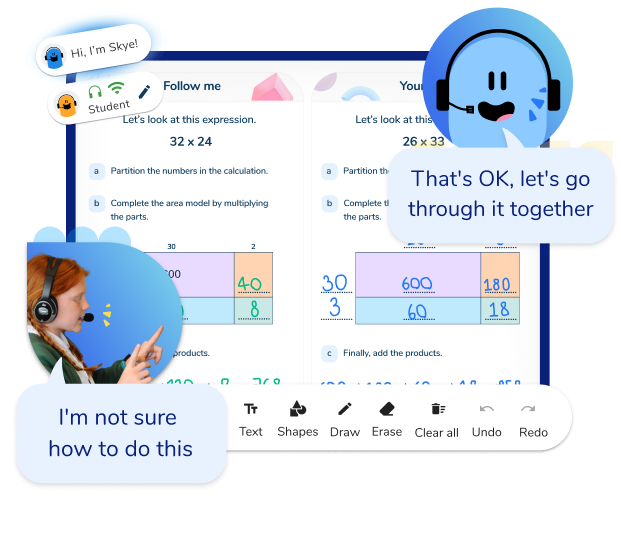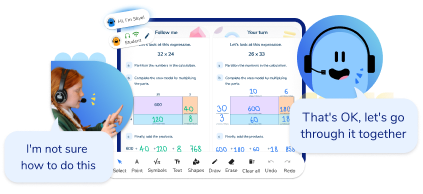What is Response To Intervention? A Practical Guide To Implementing RTI
Response to Intervention is an approach education providers use to help all students. It helps provide increasingly intense levels of targeted intervention for struggling students not making the required progress in the regular education classroom environment.
This article explores what Response to Intervention is and provides practical advice for early identification and implementation of RTI to maximize progress and achievement. We will look in depth at universal screening, high-quality instruction and effective interventions.
What is Response to Intervention?
Response to Intervention (RTI) is a schoolwide process implemented to identify and provide early intervention for students showing academic or behavioral challenges.
RTI involves a tiered system of support increasing in intensity based on individual student needs. It emphasizes data-driven decision-making to monitor progress and adjust interventions for each student as needed. It can be implemented across all grade levels, including elementary, middle, and high school.
While RTI is not a special education program, the data collected throughout the RTI process is used to help identify students with specific learning disabilities (SLD).
How does Response to Intervention work?
Within the RTI framework, there is a multi-tiered system of support (MTSS) for students based on their individual needs:
- Tier 1
- Tier 2
- Tier 3
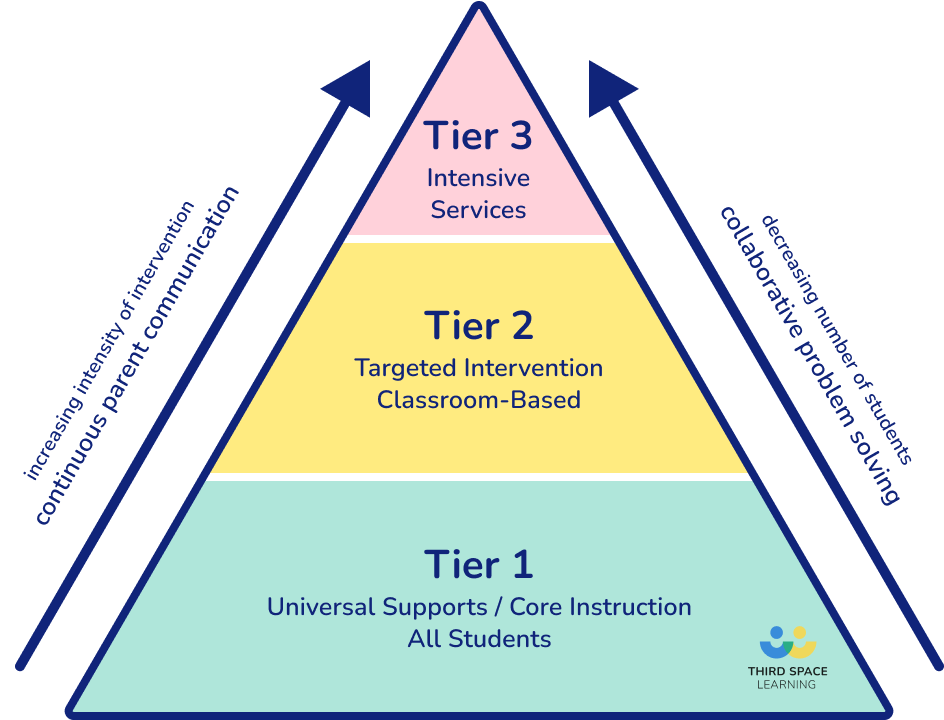
Tier 1 takes place in the general education classroom. Teachers keep a close eye on student understanding using effective questioning, formative assessment and summative assessments to identify struggling learners.
Some students then move to Tier 2 of the RTI model. During this phase, students work in small groups, in or outside of the classroom, receiving help with specific skills.
Students who still struggle after receiving Tier 1 and Tier 2 interventions move to Tier 3. At this stage, students receive intensive instruction individualized to their specific needs. This may take the form of subject-specific tutoring such as math tutoring.
Evidence-based interventions (also called research-based interventions) must be used for students receiving Tier 2 or Tier 3 support.
Response to Intervention relies heavily upon continuous data collection and collaboration among teachers, specialists and parents.
Effective Math Interventions: A Guide for Schools and Districts
A guide for school leaders and administrators on implementing successful math interventions, from RTI to Tier 3 interventions
Download Free Now!What are the Response to Intervention steps?
While Response to Intervention is a fluid process that occurs throughout the school year, the RTI process typically follows 4 steps:
1. Universal screening
All students are screened to identify those who need additional support. This screening often involves assessments in key academic areas.
2. Tiered interventions
Each RTI tier provides a different level of intervention intensity.
- Tier 1: All students receive high-quality, evidence-based instruction in the general education classroom.
- Tier 2: Students who need additional support beyond regular classroom instruction receive targeted interventions.
- Tier 3: Students who continue to struggle despite Tier 2 interventions receive more intensive, individualized interventions or high-dosage tutoring.
3. Progress monitoring
Regular assessments help educators monitor the progress of the students
receiving interventions. This helps determine whether the intervention is effective and if adjustments are needed.
4. Data-based decision making
Data collected during progress monitoring helps inform decisions about whether interventions are continued or modified. A data-driven approach ensures interventions are tailored to individual student needs.
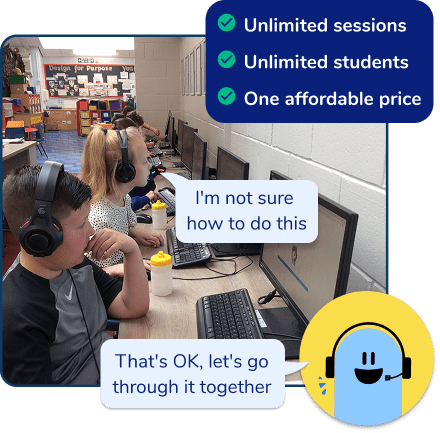
Meet Skye, the voice-based AI tutor making math success possible for every student.
Built by teachers and math experts, Skye uses the same pedagogy, curriculum and lesson structure as our traditional tutoring.
But, with more flexibility and a low cost, schools can scale online math tutoring to support every student who needs it.
Watch Skye in actionWhat are the different ways to implement Response to Intervention?
Depending on whether an intervention falls under Tier 1, Tier 2 or Tier 3, the RTI process is implemented differently.
Here’s how to implement RTI at each tier:
Tier 1: all students
All students receive high-quality, evidence-based instruction in the general education classroom from a general education teacher. Tier 1 focuses on effective teaching practices to meet the needs of the majority of learners.
Tier 2: 10% to 20% of students
Students identified as needing additional support beyond Tier 1 receive targeted interventions. Interventions may involve small group instruction, additional resources, or specific strategies to address challenges.
Tier 2 intervention examples include:
- differentiated instruction
- supplemental reading programs
- specialized math intervention groups
- social skills sessions
- peer tutoring
- behavior contracts
Tier 3: 1% to 10% of students
Students who continue to struggle after participating in Tier 2 interventions may go on to receive more intensive, individualized support. Tier 3 support may involve specialized, intensive instruction, frequent monitoring, and collaboration with specialists.
Tier 3 intervention examples include:
- personalized learning plans
- one-on-one tutoring
- specialized behavior intervention plans
- individualized counseling
- structured breaks
- pull-out groups
If students’ skills do not make the expected progress with these evidence-based interventions, teachers may refer them for a comprehensive evaluation. This will help to determine a student’s eligibility for special education services under the Individuals with Disabilities Education Act of 2004 (IDEA 2004).
What is the importance of Response to Intervention in education?
Response to Intervention (RTI) is important in education for many reasons:
- Allows educators to quickly identify and help students who may be struggling in the classroom
- Applies to both general and special education classrooms
- Prevents potential over-identification of learning disabilities
- Encourages collaboration between educators and families
- The proactive nature of RTI ensures timely support for students facing academic, behavioral, or social-emotional challenges
What is the teacher’s role in Response to Intervention?
Classroom teachers have a critical role in the implementation of the Response to Intervention process at all levels.
At Tier 1, teachers are responsible for delivering high-quality instruction in the general education classroom. They may use differentiated teaching strategies to accommodate diverse learning styles and abilities.
Teachers may also collect data and conduct screenings to identify students who may require additional support.
During Tier 2 and Tier 3, teachers implement targeted and intensive interventions. Strategies are monitored and adjusted based on the progress monitoring data.
Communication between the class teacher and parents is essential throughout the RTI process to ensure helpful strategies or solutions about an individual student’s needs are consistent between school and home.
Throughout the RTI process, class teachers should:
- keep records of interventions
- stay informed about up-to-date evidence-based practices through professional development
- be culturally sensitive to address diverse student needs
How can data inform intervention?
An essential component of the Response to Intervention (RTI) process is data collection. Teachers use data for quality instruction by analyzing student achievement and adjusting teaching strategies based on individual needs.
Data collected throughout the RTI process assists all those involved in making decisions at each level of the MTSS.
The data directly impacts the decision of each student to either maintain or adjust the level of support received. Progress monitoring of Tier 2 and Tier 3 interventions helps to determine which students are responding to the interventions and which ones are not. Precise, continuous data collection from teachers and specialists helps the RTI process be more effective.
Research strongly supports Response to Intervention (RTI) and its evidence-based practices which boosts its credibility. Many studies have explored how effective RTI is, providing valuable insights into its impact on students.
These studies help improve RTI strategies by making sure they are based on thorough research; this provides further support for schools to provide successful interventions.
What are the benefits of Response to Intervention?
Response to Intervention (RTI) has substantial benefits in education and positively influences student progress and helps close the achievement gap. RTI helps identify at-risk students early on which allows educators to provide personalized interventions tailored to a student’s specific needs. This approach has shown improvements with both academic and behavioral interventions, closing learning gaps and fostering a schoolwide culture that values each student’s success.
RTI offers flexibility in interventions and promotes collaboration, as well as a data-driven decision-making process. It creates a supportive learning environment in the general education classroom and helps to reduce the over-identification of learning disabilities. Additionally, RTI encourages parent involvement. Inform parents about their child’s progress and actively participate in their education.
What are the challenges of Response to Intervention?
Although Response to Intervention (RTI) is highly effective, it is not without its challenges:
- potential strain on resources as interventions may require extra teachers or interventionists, time, and instructional materials
- ensuring consistent collaboration among educators, specialists, and parents can be time-consuming and logistically challenging
- continuously collecting and analyzing data is time-consuming and adds to teacher’s workload
However, it is possible to overcome these challenges. Schools can:
- allocate sufficient resources and provide professional development for educators to strengthen RTI implementation
- encourage schoolwide communication and collaboration to help with coordination issues
- implement a system of regular reassessment and updating of intervention strategies based on ongoing data
- consider choosing a tuition partner for Tier 3 interventions that ease the pressure of teacher workload by tracking regular assessment and progress data
Read more: 5 Math Intervention Myths
How can Third Space Learning support Response to Intervention?
RTI resources
Third Space Learning offers a wealth of free math resources to use as part of your Tier 1, Tier 2 and Tier 3 interventions. Topic guides, covering all common core math standards, are available for general education classroom use alongside math worksheets, games and activities. A team of math experts create each unique resource to help accelerate student learning.
Summative assessment resources such as exit tickets, assessments and quizzes designed to identify misconceptions are fantastic resources to use as universal screening and collect data to help recognize students in need of Tier 2 or Tier 3 intervention.
Tier 3 math intervention
One-on-one tutoring is one of the most effective evidence-based interventions to help raise math achievement and accelerate progress. Third Space Learning provides personalized one-on-one math instruction for 2nd -8th grade students who need it most.
Designed by math specialist, each lesson aligns to state standards and follows an ‘I do, we do, you, do’ format and provides direct instruction, and guided and independent practice to help students develop math knowledge and problem-solving skills.
Student responses guide each session. Highly trained STEM specialist tutors adapt and personalize one-on-one math instruction to suit the needs of each student.
Schools receive a detailed report for each learner after every session — meaning educators and intervention organizers can easily track the progress of each student without adding to their workload.
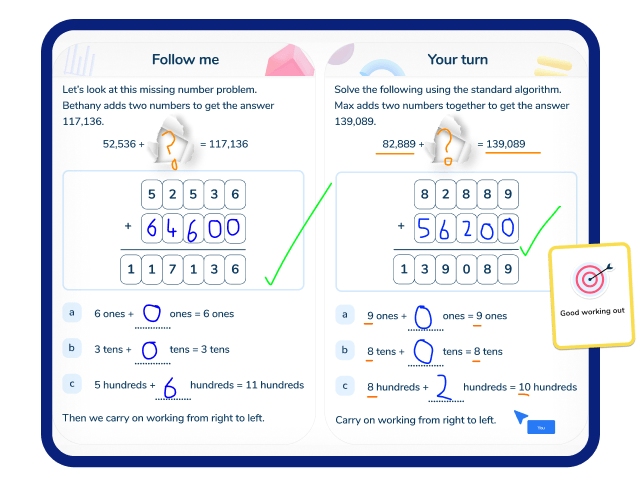
Find out how schools can use their school funding options, including ESSER funding to support Tier 3 interventions.
Read more:
- When Do ESSER Funds Expire?
- How to choose an effective summer tutoring program
- How To Manage Test Anxiety
FAQs
The four components of Response to Intervention (RTI) are universal screening, tiered interventions, progress monitoring, and data-based decision making.
The RTI process is a four-step process used to provide early and targeted support for students at different levels of need.
Tier 1, Tier 2, and Tier 3 in Response to Intervention (RTI) refer to different levels of support:
Tier 1: Universal interventions provided to all students in the general education setting.
Tier 2: Targeted interventions for students who need additional support beyond the universal level.
Tier 3: Intensive, individualized interventions for students who require more specialized assistance despite Tier 2 support.
